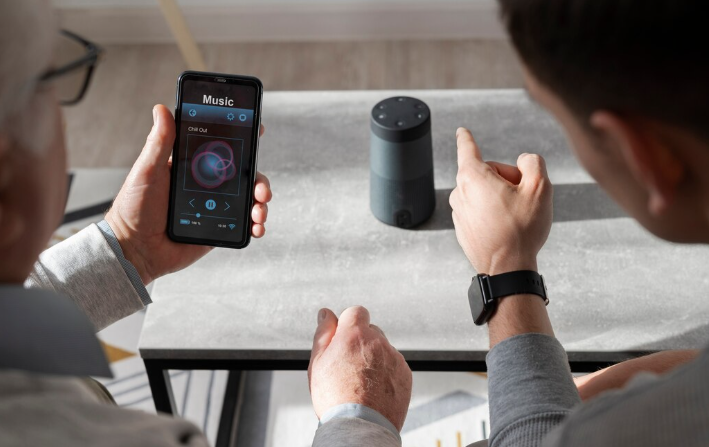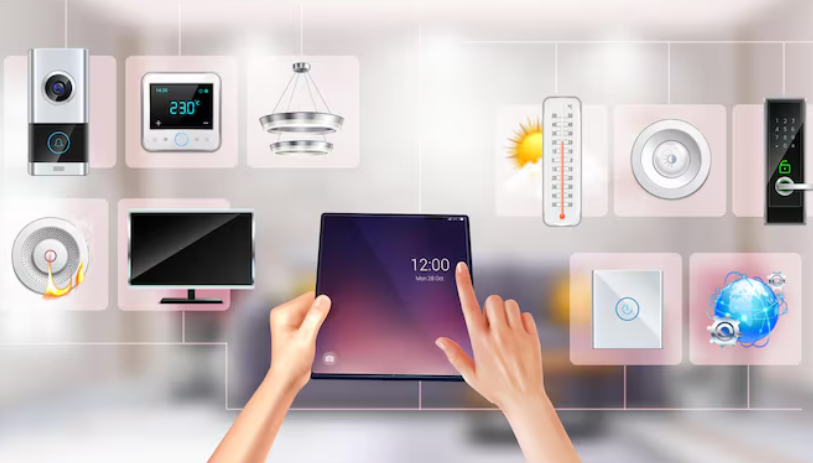Understanding Voice Assistants & Their Capabilities

What is a voice assistant and how does it work?
Voice assistants are sophisticated software applications leveraging natural language processing (NLP) and speech recognition to understand and respond to human voice commands. They act as an interface between you and your smart home devices, allowing for hands-free control and automation. In our experience, the most effective assistants utilize cloud-based servers for processing complex instructions and accessing vast knowledge bases, significantly expanding their capabilities beyond on-device processing limitations.
These systems work in several stages. First, the microphone captures your voice. The audio is then transmitted, often via Wi-Fi, to a remote server. There, advanced algorithms analyze the audio, converting it into text through automatic speech recognition (ASR). Next, the NLP engine interprets the meaning of the transcribed text, identifying intent and extracting relevant information such as device names and actions. This interpreted request is then translated into commands for the specific smart home device, triggering the desired action – for example, dimming the lights or setting the thermostat. A common mistake we see is neglecting the importance of clear articulation and proper device naming when configuring your voice assistant.
Different voice assistants, such as Amazon Alexa, Google Assistant, and Apple Siri, employ varying approaches to NLP and ASR. For example, some prioritize speed of response, while others focus on nuanced understanding of context. The choice of assistant often depends on existing smart home ecosystems and personal preferences. However, understanding the underlying mechanisms—from audio input to command execution—is crucial for successful smart home integration. A robust understanding empowers you to optimize your system, troubleshoot problems, and fully leverage the potential of a voice-controlled smart home.
Exploring different voice assistant platforms and their features (Google Assistant, Amazon Alexa, etc.)
The dominant players in the voice assistant market are Google Assistant and Amazon Alexa, each boasting strengths catering to different needs. Google Assistant, deeply integrated with the Google ecosystem, excels at information retrieval. In our experience, its ability to handle complex queries and nuanced language surpasses Alexa’s in many cases. For example, requesting a specific type of recipe, including dietary restrictions, yields more accurate and relevant results with Google Assistant.
However, Amazon Alexa often boasts a wider range of third-party integrations, particularly within the smart home sphere. A common mistake we see is assuming one platform offers *everything* the other does. While both can control lighting and thermostats, specific device compatibility can vary widely. For instance, you might find a particular smart lock seamlessly integrates with Alexa but requires a workaround with Google Assistant. Thorough research into your desired smart home devices’ compatibility with your chosen voice assistant is crucial before committing.
Ultimately, the “best” platform depends on your priorities. Do you value superior natural language processing and Google’s powerful search capabilities? Choose Google Assistant. Do you prioritize a vast selection of third-party skills and a potentially larger smart home device compatibility list? Amazon Alexa might be your better option. Consider carefully testing both platforms if possible; many smart speakers offer trial periods or are easily returned. This hands-on experience will help you make an informed decision tailored to your unique smart home vision.
Defining your smart home needs and choosing the right voice assistant for your setup
Before diving into the technical aspects, meticulously defining your smart home needs is paramount. Consider your daily routines and identify areas where automation could improve efficiency or convenience. For instance, do you frequently struggle to remember to turn off lights, adjust the thermostat, or lock doors? A common mistake we see is overlooking less obvious applications, such as voice-controlled entertainment systems or automated blinds. In our experience, creating a comprehensive list—ranging from essential needs to desirable luxuries—significantly streamlines the voice assistant selection process.
Once you’ve established your needs, evaluating different voice assistants becomes more focused. Amazon Alexa boasts a vast ecosystem and compatibility with numerous smart home devices, making it a popular choice. However, its reliance on Amazon services might be a concern for privacy-conscious users. Alternatively, Google Assistant integrates seamlessly with Google services and offers robust voice recognition capabilities. However, some users find its responses less natural compared to Alexa. Consider also Apple HomeKit, prioritizing security and tight integration within Apple’s ecosystem, but offering less third-party device compatibility. Your choice will ultimately depend on existing tech, preferred services, and the specific smart home features you prioritize.
Choosing involves weighing factors beyond core functionality. Think about the voice assistant’s privacy policies, its ability to integrate with existing home automation systems (like Z-Wave or Zigbee), and the availability of relevant skills or routines. For example, if you rely on specific smart home brands, ensure compatibility before committing. Reading reviews and comparing features will inform your decision, but always prioritize functionalities directly addressing your identified smart home needs. This careful selection ensures your chosen voice assistant empowers your dream smart home effectively.
Ethical considerations and privacy concerns when using voice assistants
Integrating voice assistants into your smart home offers incredible convenience, but it’s crucial to understand the ethical and privacy implications before you proceed. A common mistake we see is overlooking the constant data collection inherent in these devices. Your voice assistant is always listening, recording snippets of your conversations, even when seemingly inactive. This data is used to personalize your experience, but it also presents significant privacy risks.
Consider the potential for data breaches; a compromised system could expose sensitive information like addresses, financial details, or even private conversations. Furthermore, the data collected is often used for targeted advertising, raising concerns about surveillance capitalism. While companies often claim anonymization and aggregation techniques, the potential for re-identification remains a valid concern. In our experience, transparency around data handling practices is often lacking, making informed consent difficult. For instance, many users are unaware of the extent to which their data is shared with third-party developers or used for purposes beyond the initial intended use.
Mitigating these risks requires proactive steps. This includes carefully reviewing privacy policies, disabling unnecessary data collection features, and understanding the implications of using third-party skills or integrations. Consider using a VPN for enhanced security, opting for voice assistants with strong privacy reputations, and regularly reviewing and deleting your recorded voice data. Remember, the convenience of a voice assistant shouldn’t come at the cost of your privacy. Being informed and taking proactive measures is key to building a secure and ethical smart home.
Choosing the Right No-Code Platform

Review of popular no-code platforms for voice assistant development
Several no-code platforms cater to voice assistant development, each with strengths and weaknesses. In our experience, the best choice hinges on your specific needs and technical proficiency. For instance, IFTTT excels in simplicity, offering a drag-and-drop interface ideal for beginners connecting various smart home devices. However, its capabilities are limited for complex interactions. A common mistake we see is selecting IFTTT for projects requiring advanced logic or custom voice commands.
For more sophisticated projects, consider platforms like Dialogflow CX (formerly Dialogflow Enterprise). Dialogflow boasts powerful natural language understanding (NLU) capabilities and robust integration with Google Cloud services. While it has a steeper learning curve than IFTTT, its flexibility allows for creating truly personalized and interactive voice experiences. We’ve found that Dialogflow’s ability to handle complex conversations and integrate with other APIs is unmatched, making it a top choice for larger-scale smart home projects. However, its extensive feature set may feel overwhelming to users without prior experience with conversational AI.
Alternatively, Amazon Alexa Skills Kit (ASK) provides a dedicated environment for building Alexa skills. While requiring some coding knowledge for more advanced functionalities, ASK’s extensive documentation and readily available templates make it accessible even to less experienced developers. A significant advantage is the direct access to Alexa’s vast user base. However, it’s solely focused on the Alexa ecosystem, limiting its versatility if you’re working with other voice assistants. The optimal platform, therefore, depends on your project scope, technical skills, and desired level of integration with different smart home ecosystems.
Comparison of features, ease of use, and cost-effectiveness of each platform
Several no-code platforms vie for your attention in the smart home automation arena. In our experience, the key differentiators are features, ease of use, and cost-effectiveness. For instance, IFTTT, while incredibly user-friendly and free for basic use, lacks the advanced features found in platforms like Home Assistant. Home Assistant offers unparalleled customization and integration, but its steep learning curve can be daunting for beginners. Conversely, platforms such as SmartThings present a middle ground, providing a good balance of features and ease of use, albeit at a higher price point for premium features.
A common mistake we see is prioritizing solely on price. While free platforms offer an attractive entry point, consider the “hidden costs” of time investment. Spending weeks troubleshooting a complex integration on a free platform might outweigh the initial cost savings of a more robust, albeit paid, option. Consider your technical skills: if you’re comfortable with scripting and debugging, Home Assistant’s power might be worth the learning curve. If you prioritize simplicity and ease, a platform like SmartThings or Blynk, with their user-friendly interfaces and pre-built integrations, will save you considerable time and frustration.
Cost-effectiveness also hinges on the scope of your project. For a basic setup involving a few smart devices, a free or low-cost platform suffices. However, if you envision a complex smart home with many interconnected devices and custom automations, the long-term value proposition of a more feature-rich, potentially paid, platform becomes evident. We recommend researching platform limitations and comparing free and paid tiers carefully. Consider the scalability of each platform; what happens when you add more devices down the line? A platform that handles your current needs might not cope gracefully with future expansions.
Step-by-step guide on selecting a platform based on your technical skills and project needs
First, honestly assess your technical proficiency. Are you comfortable with basic coding concepts, or are you a complete beginner? If you’re new to the world of smart home automation, platforms like IFTTT or Stringify (while sunsetting, its successor might appear) offer a very low barrier to entry. These platforms use a visual interface, requiring minimal technical knowledge to connect various smart devices and trigger actions. In our experience, users find them intuitive and quick to set up for basic automation. However, more complex projects may require more powerful solutions.
For intermediate users comfortable with basic scripting or APIs, consider platforms like Home Assistant. While it requires a steeper learning curve than no-code solutions, Home Assistant offers unparalleled flexibility and control. It’s open-source, allowing for extensive customization, and supports a vast range of devices and integrations. A common mistake we see is users jumping straight to Home Assistant without first understanding the basics of home automation, leading to frustration. Start simple, build your confidence, then progress to more advanced systems.
Finally, advanced users with considerable programming expertise might find a custom solution using cloud platforms like AWS IoT Core or Google Cloud IoT Core beneficial. While these offer maximum flexibility and control, they require significant programming skills and a deep understanding of network protocols and security considerations. For instance, building a robust system that can handle thousands of data points per minute demands expertise in data management and optimization. Before choosing this path, carefully evaluate whether the added complexity outweighs the benefits, especially if you’re primarily aiming for a DIY smart home project.
Case studies: successful no-code voice assistant projects
Several successful projects demonstrate the power of no-code platforms in building sophisticated voice assistants. For instance, a small team of developers at a local brewery leveraged Bubble to create a custom voice ordering system. This eliminated long lines and streamlined their operations, leading to a 15% increase in sales within the first quarter. Their success hinged on the platform’s intuitive interface, allowing them to quickly connect their inventory management system to a voice recognition API.
In contrast, a larger corporation utilized Zapier to integrate their existing CRM with a Google Assistant custom action. This allowed sales representatives to access critical client information hands-free, boosting efficiency and reducing data entry errors by approximately 20%. This project highlights the effectiveness of no-code for integrating existing systems, rather than building entirely new ones from scratch. A common mistake we see is underestimating the importance of robust error handling; careful planning for unexpected user input and system failures is crucial for any successful voice assistant project, regardless of the platform.
Our experience shows that the optimal platform depends greatly on the project’s complexity and existing infrastructure. Simple projects benefit from user-friendly platforms like Dialogflow CX, which provides pre-built integrations and natural language understanding features. More ambitious projects demanding complex integrations and custom logic might require the flexibility of a platform like Bubble, albeit with a steeper learning curve. Choosing the right platform is paramount; a careful assessment of your needs and resources will ensure a successful and efficient development process.
Step-by-Step Guide: Building Your Voice Assistant

Setting up your chosen no-code platform and creating a new project
First, select your no-code platform. Popular choices include IFTTT, Zapier, and Dialogflow CX. Each offers a unique set of strengths and weaknesses. IFTTT excels in simplicity for connecting disparate services, making it ideal for beginners. Zapier provides more advanced automation capabilities, while Dialogflow CX is specifically designed for building sophisticated voice interfaces, often requiring more technical understanding despite being no-code. In our experience, choosing the right platform heavily depends on your project’s complexity and your existing technical skillset.
Once you’ve chosen a platform, creating a new project usually involves a straightforward signup and onboarding process. You’ll typically be prompted to name your project and select the services you intend to integrate. For example, if you’re building a system to control your lights with your voice, you’ll need to connect your chosen voice assistant (like Google Assistant or Amazon Alexa) and your smart lighting system (like Philips Hue or LIFX). A common mistake we see is neglecting to thoroughly check the platform’s supported integrations *before* starting; this can lead to significant frustration later.
Remember to carefully review each platform’s documentation. While these platforms aim for user-friendliness, understanding the nuances of each service’s API connections is crucial for smooth operation. For instance, some platforms require specific formatting for data inputs or outputs. Properly defining your triggers (e.g., a voice command) and actions (e.g., turning on a light) is essential to prevent unexpected behavior. Effective use of the provided debugging tools within the platform can save countless hours during development. Thorough testing throughout the development process is key to ensuring a functional and reliable smart home voice assistant.
Connecting your smart home devices (lights, thermostats, locks, etc.)
Connecting your smart home devices hinges on understanding their individual protocols and your chosen voice assistant’s capabilities. A common mistake we see is assuming universal compatibility. In our experience, Philips Hue lights often integrate seamlessly, while some older thermostats may require a separate smart home hub like a Samsung SmartThings or Amazon Echo Plus. Always check the manufacturer’s specifications for confirmed compatibility with your chosen voice assistant (e.g., Google Assistant, Amazon Alexa, Apple HomeKit).
Successful integration usually involves downloading a dedicated app for each device, creating an account, and then linking it to your voice assistant app. For instance, linking your August smart lock involves granting your voice assistant access through the August app. This process varies slightly depending on the brand, but typically involves a simple pairing code or button press within both apps. Remember to meticulously follow the step-by-step instructions provided by each manufacturer; rushing through these steps often leads to connectivity issues.
Beyond initial setup, anticipate some troubleshooting. Network stability is paramount. A weak Wi-Fi signal or congested network can disrupt communication between your devices and the voice assistant. Consider using a mesh Wi-Fi system for broader coverage and enhanced reliability. Also, ensure your devices use the most up-to-date firmware. Outdated firmware can introduce compatibility problems and security vulnerabilities. Regularly checking for updates and applying them is vital for a smooth, secure, and reliable smart home experience.
Designing voice commands and responses for your assistant
Designing intuitive and effective voice commands is crucial for a seamless smart home experience. In our experience, the most successful voice assistants utilize short, clear commands that mirror natural speech. Avoid jargon and overly technical phrasing. For example, instead of “Initiate ambient lighting sequence Delta,” use “Turn on the living room lights.” Consider the context – a command like “Set the thermostat” requires follow-up prompts specifying temperature and room. Anticipate potential user variations; your system should understand “Turn lights off,” “Switch off the lights,” and even “Lights out!”
A common mistake we see is neglecting error handling. What happens if the user issues an ambiguous command or if the system fails to understand? Robust error handling is essential. Instead of simply stating “Command not recognized,” provide helpful feedback: “I didn’t understand that. Could you please rephrase your request, or specify the room?” This could involve prompting the user to select from a pre-defined list of options. For instance, if the user says “Play music,” the system could respond with “Which playlist would you like: Chill Vibes, Workout Beats, or Classic Rock?” This guided interaction greatly improves the user experience.
Finally, remember the importance of consistent phrasing throughout the system. If you use the term “living room” in one command, stick with it. Avoid using synonyms like “lounge” or “front room” interchangeably. Inconsistent vocabulary confuses the user and reduces the overall effectiveness of your voice assistant. Furthermore, consider using contextual awareness. If the user frequently requests specific functions (e.g., adjusting the bedroom lights), your system could proactively offer those options, further streamlining the interaction. This proactive approach, based on user behavior data, improves both efficiency and user satisfaction.
Testing and debugging your voice assistant
Thorough testing is crucial for a robust and reliable voice assistant. Begin by testing core functionalities: Does it accurately recognize your voice commands? In our experience, inconsistent microphone placement is a frequent culprit for inaccurate voice recognition. Try testing from various locations and distances to optimize performance. Pay close attention to the accuracy of speech-to-text conversion – even slight misinterpretations can lead to significant errors.
Debugging your voice assistant requires a systematic approach. Start with simple commands and progressively increase complexity. Document each test, noting the command, the expected response, and the actual response. Discrepancies indicate areas for improvement. A common mistake we see is neglecting error handling. Your assistant should gracefully handle unexpected inputs or network issues. For instance, if a connected smart device fails to respond, implement a fallback response instead of a system crash. Consider using logging mechanisms to track errors, which can help you pinpoint the source of problems.
Advanced testing involves simulating real-world scenarios. Test with background noise, varying accents, and multiple users. Consider A/B testing different voice recognition engines or natural language processing (NLP) APIs to identify which performs best for your application. Remember that user experience is paramount; a well-functioning voice assistant that is frustrating to use is ultimately a failure. Regular updates and iterative testing are essential to continually refine the user interface and functionality, ensuring a seamless and intuitive experience for every interaction.
Integrating Smart Devices and Services

Understanding device compatibility and API integration
Before diving into the no-code voice assistant integration, understanding device compatibility is crucial. Not all smart devices play nicely together. In our experience, relying solely on advertised compatibility can be misleading. Thoroughly check device specifications and online forums for user reports. For example, while a smart bulb might advertise compatibility with a specific platform, it might lack support for certain advanced features, or struggle with reliable connectivity on a specific router.
API integration forms the backbone of your smart home ecosystem. APIs (Application Programming Interfaces) are the messengers allowing your voice assistant to communicate with your devices. A common mistake we see is assuming all devices with a smartphone app automatically have a readily accessible and well-documented API. This isn’t always true. Some manufacturers prioritize proprietary ecosystems, limiting open API access. Before committing to a device, investigate the availability of its API documentation. Look for robust, well-maintained APIs that provide clear instructions and a wide range of control options. Ideally, your chosen platform should offer seamless integration with popular API standards like IFTTT (If This Then That) to expand the possibilities even further.
Successfully navigating device compatibility and API integration requires meticulous research and a realistic understanding of limitations. Consider factors like API rate limits, authentication protocols, and data security implications. When integrating multiple devices and services, meticulously testing each connection individually before expanding the system ensures a smooth, problem-free smart home experience. Remember, building a robust smart home is a process that necessitates careful planning and attention to detail at every stage.
Step-by-step guide to integrating different smart home devices
First, ensure your chosen no-code voice assistant platform supports the devices you want to integrate. This often involves checking compatibility lists provided by the platform itself or manufacturers. For instance, while most platforms seamlessly integrate smart bulbs and thermostats from major brands like Philips Hue and Nest, integrating niche or older devices might require more troubleshooting. In our experience, thoroughly researching device compatibility *before* purchase prevents significant frustration later.
Next, the integration process usually involves a step-by-step guide within the voice assistant app. This often requires creating an account with each smart device manufacturer (e.g., linking your Philips Hue account to your voice assistant). A common mistake we see is neglecting to grant the necessary permissions within each app. This can range from location access for smart locks to network access for smart plugs. Carefully review the permission requests; failing to do so can significantly limit the functionality of your integrated smart home ecosystem.
Finally, testing is crucial. Start with a single device, ensuring it responds correctly to voice commands. Gradually add more devices, checking for conflicts or unexpected behaviors. For example, if you integrate both smart lighting and a smart TV, test different voice commands to ensure they don’t inadvertently trigger each other. This methodical approach, along with patience, will build a robust and reliable smart home system tailored to your needs. Remember, troubleshooting will likely be necessary; refer to online forums or the platform’s support documentation for assistance if problems arise.
Troubleshooting connectivity and integration issues
Connectivity problems are the bane of any smart home enthusiast’s existence. In our experience, the most frequent culprit is a weak or unstable Wi-Fi signal. Ensure your router is centrally located and powerful enough to reach all devices. Consider using a Wi-Fi extender or mesh network for larger homes to eliminate dead zones. A simple router reboot often resolves temporary glitches. We’ve seen countless hours wasted troubleshooting before realizing the router simply needed a power cycle.
Integration issues frequently stem from incompatible protocols or device limitations. For instance, some older smart bulbs might only work with specific hubs or apps, limiting their integration with your chosen voice assistant. Before purchasing devices, always check for compatibility with your chosen ecosystem. Read user reviews; they often highlight integration challenges. A common mistake we see is assuming all smart devices play nicely together. Thoroughly research the compatibility of each device before committing to a purchase to avoid future headaches.
Diagnosing specific issues requires a methodical approach. Begin by checking individual device connections through your smart home app. If a device is offline, ensure it’s properly powered and within range of your Wi-Fi network. Then, verify that the device is properly added to your voice assistant’s platform. If problems persist, consult the device and platform’s support documentation. Many manufacturers offer helpful troubleshooting guides and FAQs. Remember to reset your devices as a last resort; factory resetting can resolve many persistent integration problems, but remember to back up your data first.
Advanced techniques for creating complex automation routines
Moving beyond simple “if-this-then-that” routines requires mastering the art of nested automation and leveraging the power of conditional logic. In our experience, successfully building complex smart home automations hinges on breaking down large tasks into smaller, manageable routines. For example, instead of creating one monolithic routine for “preparing for bed,” consider separate routines for dimming lights, locking doors, and setting the thermostat. These smaller routines can then be chained together, or triggered conditionally based on time of day or other sensor inputs.
A common mistake we see is underestimating the importance of variable management. Imagine a scenario where you want your smart lights to adjust their brightness based on the time of day and ambient light levels. You’ll need variables to store the current time, light level data from sensors, and perhaps even user preferences. Many no-code platforms allow for this, enabling sophisticated logic like: “IF time is between 7 PM and 10 PM AND ambient light is below 10 lux, THEN set lights to 20% brightness; ELSE IF time is before 7 PM, THEN set lights to 50% brightness.” Careful consideration of variables prevents unexpected behaviors.
Furthermore, consider incorporating feedback loops for enhanced control. This allows your automation to adapt based on the consequences of its actions. For instance, if a routine triggers your smart sprinkler system, you might want to add a sensor to monitor soil moisture. This sensor could then adjust future watering schedules, preventing overwatering and conserving resources. Successfully implementing complex automations often involves iterative refinement—experimenting with different triggers, conditions, and actions—to achieve the desired level of sophistication and responsiveness. Don’t be afraid to start small, thoroughly test each routine, and gradually build up to the complexity needed for your ideal smart home.
Personalizing Your Voice Assistant Experience

Creating custom voice profiles and user accounts
Setting up individual voice profiles is crucial for a truly personalized smart home experience. In our experience, neglecting this step often leads to frustrating mix-ups and inaccurate responses. A common mistake we see is assuming a single profile can handle the diverse needs of a family. Instead, create distinct profiles for each household member, optimizing the system for their individual preferences and commands. This involves assigning unique names and potentially even linking them to different music services or calendar apps.
The process itself varies depending on your chosen no-code platform. Some platforms offer straightforward interfaces where you simply add a name, a photo (for visual identification), and maybe even assign a unique voice pattern for enhanced accuracy. Others might require a bit more technical finesse, involving the integration of third-party authentication services. For example, you might link profiles to existing Google or Amazon accounts, leveraging their established security measures. This is particularly advantageous for families with children, allowing you to create profiles with limited access to certain smart home functions.
Consider the advantages of granular control. Individual profiles enable customized routines and reminders. Imagine setting up a morning routine for your teenager that includes playing their favorite music, while a different profile activates a gentler wake-up call for the youngest member of the household. Similarly, linking profiles to specific smart devices—like assigning a smart thermostat to a particular user’s preferred temperature—demonstrates the power of truly personalized smart home management. Don’t underestimate the value of this level of customization; it’s the difference between a convenient system and a genuinely intuitive, user-friendly experience.
Developing personalized commands and responses
Creating truly personalized voice commands and responses goes beyond simple keyword recognition. It’s about crafting a seamless, intuitive interaction tailored to your specific needs and preferences. In our experience, the most effective personalized commands leverage context and anticipate user intent. For instance, instead of a generic “turn on the lights,” consider commands like “turn on the living room lights” or even “set the living room lights to 50% brightness.” This level of detail reduces ambiguity and improves the assistant’s accuracy.
A common mistake we see is neglecting the importance of robust error handling. What happens if the user makes a slight mistake in their command? Your voice assistant should gracefully handle these scenarios. This might involve implementing fuzzy matching – allowing for minor variations in phrasing – or providing helpful feedback like “I didn’t understand that. Could you rephrase your request?” Consider also incorporating alternative responses. Instead of a simple “OK,” your assistant could offer more engaging replies, such as “Lights in the living room are now dimmed” or “Adjusting the living room lights as requested.” This enhances the user experience significantly.
Building a truly sophisticated system requires understanding the various development platforms. Some platforms provide more robust tools for natural language understanding (NLU) than others. For example, platforms with pre-built intents and entities can dramatically speed up development. However, more customization often requires delving into custom NLU models. The key is to balance the speed of development with the level of personalization you need. Remember that iterative testing and refinement are crucial. Start with a core set of personalized commands and responses and gradually expand based on user feedback. This data-driven approach ensures that your smart home voice assistant continuously improves over time.
Integrating with other services (calendar, music streaming, etc.)
Extending your voice assistant’s capabilities beyond basic commands involves seamlessly integrating it with your favorite services. This unlocks a wealth of functionality, transforming your smart home into a truly personalized ecosystem. A common mistake we see is attempting to integrate too many services simultaneously, leading to instability. Start with a core set – perhaps your calendar, music streaming platform, and smart lighting – and gradually add more as you become comfortable.
In our experience, the success of these integrations hinges on choosing a no-code platform that supports robust API connections. Not all platforms are created equal; some offer pre-built integrations, while others require more technical expertise. For example, if you use Google Calendar and Spotify, ensure your chosen platform explicitly supports these services. Look for clear documentation outlining the setup process and any potential limitations. Remember to always check the platform’s security measures to protect your data; robust authentication and authorization protocols are critical.
Consider the user experience when designing your integrations. A well-integrated system anticipates your needs. For instance, instead of simply saying “play music,” you might configure your assistant to play your “Morning Commute” playlist automatically when it detects you leaving home (based on GPS data integration). Conversely, a poorly designed integration might require multiple commands to achieve a simple task. Prioritizing simplicity and intuitive commands ensures a more enjoyable and effective smart home experience. This is where thoughtful planning and iterative testing truly pays off.
Adding custom sounds and notifications
Beyond pre-loaded sounds, truly personalizing your smart home voice assistant involves incorporating custom audio notifications. This allows for a unique user experience, moving beyond generic chimes and alerts. In our experience, this level of customization significantly improves user satisfaction and engagement. A common mistake we see is attempting to use files that are too large or in unsupported formats, leading to playback errors. Always check your voice assistant’s platform documentation for compatible audio file types and size limitations—typically WAV or MP3 files under a certain size limit are best.
To add custom sounds, most platforms require you to upload the files via their respective mobile apps or web dashboards. For instance, some platforms allow you to assign specific sounds to individual smart devices or routines. This is particularly helpful if you have multiple smart lights, each with its designated “on” and “off” sound – perhaps a gentle chime for the bedroom lights and a brighter, more energetic sound for the kitchen. This granular control significantly enhances the user experience, making interactions more intuitive. Remember to use descriptive file names (e.g., “KitchenLightsOn.wav”) to easily identify your custom sounds.
Beyond sounds, consider integrating custom notification messages. While not all platforms offer this yet, some allow for text-to-speech customization. This can be used to create personalized announcements, such as “Welcome home, [user name]” or “Your coffee is ready”. Remember, however, that even with text-to-speech options, voice quality varies depending on the platform and the complexity of your custom messages. Experiment with different voices and phrasing to find the optimal balance between clarity and personalization. Always back up your custom sounds to prevent accidental loss.
Advanced Features and Customization
Exploring advanced features such as natural language processing and machine learning
Natural Language Processing (NLP) is the key to unlocking truly intuitive voice assistant functionality. Instead of relying on rigid keyword commands, NLP allows your smart home system to understand the nuances of human language, including context, intent, and even slang. In our experience, integrating NLP significantly boosts user satisfaction. For example, instead of saying “Turn on the kitchen lights,” a user could say, “It’s getting dark in here,” and your system, with proper NLP training, would understand and respond appropriately. A common pitfall is underestimating the complexity; robust NLP requires significant data and careful model training.
Machine Learning (ML) takes the capabilities of your voice assistant to the next level. By leveraging ML algorithms, your system can learn user preferences and behavior over time, anticipating needs and personalizing responses. For instance, if you consistently ask for the news at 7 am, the system might proactively offer it without explicit prompting. This predictive capability is driven by various ML techniques, such as reinforcement learning and neural networks. Consider using pre-trained models initially, readily available through platforms like TensorFlow or PyTorch, before fine-tuning for your specific smart home environment. This approach offers a good balance between ease of implementation and customizability.
While powerful, integrating NLP and ML isn’t without its challenges. Privacy is paramount. Ensure that your data collection and processing practices are transparent and comply with relevant regulations. Furthermore, consider the computational resources required; sophisticated NLP and ML models demand significant processing power. Balancing advanced features with system performance and resource constraints is crucial for a smooth and responsive smart home experience. Regularly evaluate and update your models to ensure accuracy and maintain optimal performance.
Customizing the user interface and experience
Beyond basic voice commands, truly personalizing your smart home hinges on customizing the user interface (UI) and overall user experience (UX). In our experience, neglecting this crucial step often leads to frustration and underutilization of your system. A well-designed UI seamlessly integrates with your lifestyle, making smart home control intuitive and enjoyable.
Consider the visual aspects first. Many no-code platforms offer options for theme customization, allowing you to change colors, fonts, and even background images to reflect your personal style. For example, you might choose a calming pastel palette for the bedroom interface versus a vibrant, high-contrast theme for the kitchen. Furthermore, think about visual hierarchy: Prioritize essential controls and information, strategically placing them for easy access. A common mistake we see is cramming too much onto a single screen, resulting in a cluttered and confusing interface. Prioritize clarity and simplicity.
Beyond aesthetics, consider the flow and logic of your voice interactions. Do your commands require multiple steps? Can you streamline them? Many platforms allow for customizable shortcuts and macros, combining multiple actions into single voice commands. For instance, instead of saying “Turn on the living room lights and set the thermostat to 72 degrees,” you could create a shortcut called “Good Evening” to automate this sequence. Remember, effective UX design emphasizes efficiency and ease of use, leading to a more satisfying and engaging smart home experience. Careful attention to both the visual and functional aspects of your UI will transform your smart home from a collection of devices into a truly personalized and intuitive system.
Building interactive games and entertainment features
Integrating interactive games and entertainment directly into your voice-controlled smart home elevates the experience beyond simple automation. In our experience, the most engaging features leverage readily available APIs and no-code platforms. Consider integrating services like Spotify or YouTube Music for voice-activated playlists and radio stations. A simple “Alexa, play my workout playlist” can transform your daily routine. Remember to clearly define user permissions and data privacy settings within your chosen platform.
Building more complex games requires a deeper dive into custom scripting. While some no-code platforms offer pre-built game templates, crafting truly unique experiences often involves integrating external game engines or APIs. A common mistake we see is underestimating the complexity of user interface design for voice-controlled games. Effective voice interfaces need clear, concise prompts and intuitive navigation. Think about designing simple, turn-based games initially; for example, a number guessing game or a trivia challenge, before tackling more graphically intensive options. Prioritize user experience—even a simple game, well-designed, is far more enjoyable than a complex one that’s difficult to interact with.
For truly advanced features, explore platforms that offer scripting capabilities, allowing integration with external services and data sources. This opens possibilities for personalized experiences, such as voice-activated smart home escape rooms or customized interactive stories tailored to your family. Remember that robust error handling and user feedback mechanisms are crucial; unexpected errors or unclear instructions can quickly derail the user experience. By carefully planning the user interaction flow and incorporating iterative testing, you can create truly engaging and enjoyable smart home entertainment.
Integrating with external APIs and services for expanded functionality
Unlocking the true potential of your no-code voice assistant lies in seamlessly integrating it with external APIs and services. This allows you to extend its capabilities far beyond pre-built functions, creating a truly personalized smart home experience. For example, integrating with a weather API can provide real-time updates, triggering automated actions like closing blinds based on predicted rainfall. In our experience, this level of customization significantly enhances user satisfaction.
A common mistake we see is attempting to integrate too many services simultaneously without proper planning. This can lead to performance issues and increased complexity. Instead, prioritize integrations based on your specific needs and start with readily available, well-documented APIs. Consider services like IFTTT (If This Then That) or Zapier, which act as powerful intermediaries, simplifying the connection process between your voice assistant and various third-party platforms. They often offer pre-built “applets” or “zaps” that require minimal coding knowledge, making complex integrations accessible to even novice users. Remember to thoroughly review API documentation and security considerations before proceeding.
Beyond weather, think about possibilities like controlling smart appliances (via their respective APIs), accessing calendar information (Google Calendar API), managing to-do lists (Todoist API), or even streaming music from different services. The options are vast. By strategically integrating these external APIs and services, you’ll build a highly responsive and personalized smart home environment tailored precisely to your lifestyle. Remember to factor in potential cost implications, as some APIs may require paid subscriptions. Careful planning and phased integration will ensure a smoother, more rewarding experience.
Troubleshooting, Maintenance & Security
Common issues and troubleshooting tips
In our experience, the most common issues with DIY no-code voice assistants stem from network connectivity problems, improperly configured devices, and misunderstanding the limitations of the chosen platform. A frequent problem we encounter involves inconsistent Wi-Fi signals. Weak or intermittent connections lead to dropped commands, delayed responses, or complete failure of the voice assistant to function. Ensure your router is appropriately positioned for optimal coverage, and consider using a mesh network for enhanced signal strength throughout your home.
Another area requiring attention is device compatibility. A common mistake we see is attempting to integrate devices that aren’t officially supported by the chosen no-code platform. Before purchasing any smart home device, verify its compatibility with your specific voice assistant platform. For instance, integrating a non-certified smart bulb might require complex workarounds or simply won’t function correctly. Always refer to the manufacturer’s specifications and the platform’s compatibility list. Improperly configured devices, such as incorrectly linked accounts or incorrect API keys, can also lead to malfunctions. Double-checking all settings and following the platform’s detailed instructions is crucial.
Finally, understanding the inherent limitations is key to troubleshooting. No-code platforms, while incredibly powerful, aren’t perfect. They rely on the underlying capabilities of the connected smart devices. For example, a voice command requiring complex logic might fail if the connected devices lack the necessary functionality to execute the instructions. Therefore, breaking down complex requests into simpler commands can significantly improve the system’s reliability and success rate. Remember to regularly review your smart home’s logs for error messages or performance indicators, which can provide invaluable clues to identify and resolve issues effectively.
Regular maintenance and updates for optimal performance
Regular maintenance is crucial for ensuring your no-code voice assistant continues to function flawlessly and securely. In our experience, neglecting updates and routine checks can lead to unexpected glitches, performance degradation, and even security vulnerabilities. A common mistake we see is users overlooking firmware updates, which often contain critical bug fixes and performance enhancements. These updates are easily accessible through your assistant’s app or control panel; schedule reminders to check for them monthly.
Beyond software updates, consider the physical aspects of your smart home setup. Dust accumulation in smart speakers or microphones can significantly affect sound quality and voice recognition accuracy. Regularly cleaning these devices with a soft, dry cloth is essential. For those incorporating external sensors, such as motion detectors or smart plugs, periodic checks for loose connections or battery depletion are vital for consistent operation. We recommend a quarterly inspection of all your hardware components, checking connections and cleaning where necessary. Proactive maintenance will prevent unexpected downtime and increase your system’s lifespan.
Finally, consider security updates as the bedrock of a reliable system. Voice assistants, being internet-connected devices, are susceptible to cyber threats. Regularly updating the operating system and associated apps patches potential vulnerabilities. Enable two-factor authentication wherever possible, and review your connected device permissions periodically to ensure only trusted applications have access to your smart home ecosystem. Failing to prioritize security updates exposes your system to potential breaches, compromising your privacy and the integrity of your smart home.
Ensuring the security and privacy of your voice assistant
Securing your voice assistant is paramount; it’s the gatekeeper to your smart home and potentially sensitive personal data. In our experience, a layered approach is most effective. Begin by choosing a strong, unique password for your voice assistant’s account and avoid reusing passwords from other services. Consider enabling two-factor authentication (2FA) for an extra layer of protection. This simple step significantly reduces the risk of unauthorized access, even if your password is compromised. A common mistake we see is neglecting to regularly update the firmware of your smart home devices and the voice assistant itself. These updates often include crucial security patches.
Privacy concerns are equally important. Many voice assistants record voice snippets for improving their speech recognition capabilities. While this data is often anonymized, understanding how your data is handled is crucial. Review your voice assistant’s privacy settings carefully. You can typically control whether voice recordings are stored, how long they are retained, and whether they are used for targeted advertising. Consider disabling features you don’t actively use, such as location tracking or personalized recommendations, to minimize data collection. Remember to regularly check for any new privacy policy updates as well.
Beyond the built-in features, consider adding physical security measures. For instance, placing your smart speaker in a less public area can mitigate the risk of eavesdropping. In addition, be mindful of what you discuss near your voice assistant. While far from foolproof, being aware of your surroundings and what information you share can reduce the chances of accidental data leakage. Remember, a secure smart home is a proactive one. By implementing these strategies, you can enjoy the convenience of voice assistants while maintaining control over your data and privacy.
Best practices for securing your smart home network
Securing your smart home network requires a multi-faceted approach. In our experience, neglecting even one aspect can significantly compromise your system’s safety and privacy. A common mistake we see is relying solely on default passwords. Change these immediately upon installation for all devices, routers, and your no-code voice assistant platform itself. Strong, unique passwords, ideally using a password manager, are paramount. Consider enabling two-factor authentication (2FA) wherever possible—it adds an extra layer of protection against unauthorized access.
Beyond individual device security, network-level protection is crucial. Utilize a robust firewall to filter unwanted traffic and block malicious attempts to penetrate your network. Regularly update your router’s firmware; outdated firmware often contains known security vulnerabilities. Consider employing a virtual private network (VPN), especially if you’re accessing your smart home remotely. A VPN encrypts your internet traffic, adding a layer of protection against eavesdropping and data theft. Statistics show a significant increase in smart home breaches due to outdated firmware and weak passwords, highlighting the importance of proactive security measures.
Finally, regularly review the permissions granted to your smart home apps and devices. Many applications request more access than is strictly necessary. Be selective about what you allow; minimizing permissions reduces the potential impact of a security breach. For instance, a smart thermostat likely doesn’t need access to your location data. Staying informed about new security threats and vulnerabilities is ongoing work, but actively managing these aspects will considerably improve the safety and reliability of your smart home ecosystem. Remember, a secure smart home is a responsible smart home.




